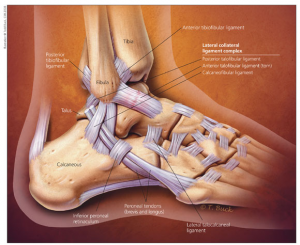LATERAL ANKLE SPRAIN
ANATOMY & MECHANISM
The most common type of sprain to the ankle occurs when the foot rolls inwards. When this happens, one or more of the ligaments on the outside of the ankle get stretched or, if the force is great enough, tear.
There are 3 ligaments on the outside of your ankle, called the anterior talofibular ligament, posterior talofibular ligament and the calcaneofibular ligament:
This type of injury, called an inversion ankle sprain, is common in sports such as netball, basketball, soccer and running. Simply stepping off a curb awkwardly or twisting your foot on uneven ground can also result in an inversion ankle sprain.
SIGNS AND SYMPTOMS
- Pain and swelling around the outside of the foot
- Difficulty and pain with walking
- Pain particularly when turning the foot in
The extent of the signs and symptoms will depend on the severity of the sprain and the number of ligaments involved.
Grade 1 – Only a few of the ligament fibers are torn
Grade 2 – Roughly 50% of the ligament fibers are torn
Grade 3 – The ligament has ruptured (torn through completely)
TREATMENT
Immediate treatment, and within the first 3 days, consists of the RICE principles:
Rest – rest the ankle, avoid too much walking and refrain from playing sport.
Ice – Every 2 hours apply ice, this will help with the pain and swelling.
If using an ice pack (or frozen peas), leave it on for 10-20 minutes, using a tea towel or similar between the pack and skin to prevent ice burn.
If using an ice cube, “massage” the outside of your ankle with the ice, gently rubbing it over the skin. Keep the ice cube moving to prevent ice burn and do this for no longer than 5 minutes.
Compression – Use an ankle brace or slightly tight sock, or even better Tubigrip, on the ankle to apply some compression, this will help to alleviate the swelling.
Elevation – Prop your leg up so that your ankle is elevated above the level of your heart. This will help to minimise the swelling.
From there, physiotherapy treatment will start with gentle movement, strengthening and balance exercises. Once the ligaments have healed sufficiently more vigorous exercises, such as agility and sport specific training. Your physiotherapist may recommend using an ankle brace when returning to sport, either initially or for ongoing use. This will depend on the individual and the nature of the injury.
Leave a reply



Leave a reply